December 12, 2008
Air Date: December 12, 2008
FULL SHOW
SEGMENTS
Progress Report from Poland
View the page for this story
Thousands of delegates from nearly 190 countries converged on Poznan, Poland to chart a new path forward on climate change. Progress was modest at this meeting but Massachusetts Senator John Kerry tells host Steve Curwood that he’s optimistic the U.S. will play a vital part in cutting greenhouse gas emissions and forging an effective climate treaty under the next administration. (12:30)
A Treaty to Slow Deforestation
/ Ingrid LobetView the page for this story
Cutting and burning trees releases more greenhouse gases than all the vehicles driving around the world, so protecting the world’s tropical forests was high on the agenda at the UN climate talks in Poland. As Living on Earth’s Ingrid Lobet reports, the indigenous groups most affected by deforestation haven’t yet had a place at the table when decisions are made about climate policy. (07:35)
Solar's Bright Future
View the page for this story
Renewable energy is a vital and increasingly desirable part of the world’s energy mix if climate change is to be tackled. But at the Poznan summit, discussion about solar power was virtually absent from the agenda. Still, host Steve Curwood reports that some solar advocates are optimistic about the future of harnessing energy from the sun. (05:00)
Obama’s Environment Team Takes Shape
/ Jeff YoungView the page for this story
The president-elect’s picks for the top environment and energy posts are starting to take shape. Living on Earth’s Jeff Young tells us who they are and what they’ll bring to the fight against climate change. (05:30)
Poznan's Alphabet Soup
/ Bruce GellermanView the page for this story
Part of the challenge of navigating the international climate talks in Poznan, Poland is keeping all the acronyms straight! Living on Earth’s Bruce Gellerman sorts through the COPs, MOPs, CDMs and GHG’s at the UNFCCC, the United Nations Framework Convention on Climate Change. (03:30)
Seeing Our Planet, Finding Ourselves
View the page for this story
Astronauts saw their home planet from space for the first time forty years ago, and the picture of a round, blue, whole Earth has been a source of reflection – and revelation - ever since. Robert Poole, author of the new book "Earthrise: How Man First Saw the Earth" tells host Steve Curwood how the picture was captured and how it's changed history. (08:30)
A Taste of Tales to Come
View the page for this story
Stories can empower, entertain, and educate. And in the Hmong-American community, they also keep the memory of past struggles alive. Hmong-American storyteller Tou Ger Xiong brings us a sample of Living on Earth's Asian-American storytelling special coming up next week, by reviving his family's tale of crossing the Mekong River to escape persecution. (03:15)
This week's EarthEar selection
listen /
download
Polish boy and girl scouts march through a cold, December night.
Show Credits and Funders
Show Transcript
Host: Steve Curwood
Guests: James Connaughton, John Kerry, Jennifer Morgan, Richard Poole, Tou Ger Xiong
Reporters: Bruce Gellerman, Ingrid Lobet, Jeff Young
[THEME]
CURWOOD: From Public Radio International this is Living on Earth. I’m Steve Curwood at the U.N. climate talks in Poznan, Poland.
With the world waiting for the U.S. to rejoin the Kyoto climate process, there was little progress in tough talks here in Poland. But John Kerry, the eyes and ears of President-elect Obama at the meeting, says he’s optimistic.
KERRY: Ultimately we are going to succeed. It is going to take some mighty cajoling and some mighty pushing, kicking and arm twisting and screaming a little bit, but we’re gonna get there - because the alternative is frankly too catastrophic to consider.
CURWOOD: Also the drive to prevent the destruction of forest and the release of their greenhouse gases takes a turn at human rights.
NARAIN: Forests are about the survival of large numbers of poor people and this is not a resource that we can allow the world to play around with.
CURWOOD: The climate talks in Poznan, Poland this week on Living on Earth. Stick Around!
ANNOUNCER: Support for Living on Earth comes from the National Science Foundation and Stonyfield Farm.
Progress Report from Poland
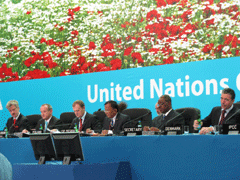
Opening remarks at UN climate change talks. (Courtesy of UNFCCC)
[THEME]
CURWOOD: From the U.N. Climate Change Conference in Poznan, Poland, this is Living on Earth. I’m Steve Curwood.
[SOUND OF BAGPIPES]
CURWOOD: A bagpiper walks through the cobblestone streets of Old Market Square in Poznan.
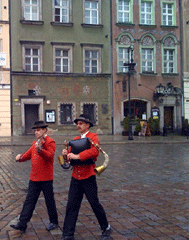
Musicians in Poznan. (Photo: Bruce Gellerman)
[CHRISTMAS CAROLS IN POLISH]
CURWOOD: Through wars and rebellion, Poznan has endured - in part, because of the population’s steadfast faith. The city is where the first Catholic cathedral was built in this part of Europe. In Polish, Poznan means “meeting place” and today locals and tourists gather during the Christmas season in the Old Market Square, where the town hall is topped by a clock that features two metal billie goats that butt heads at high noon. But for the past 12 days, to see some real head butting, head over to Poznan’s International Fairgrounds just beyond the market square.
[SOUNDS OF MEETINGS]
CURWOOD: It’s here that over 10,000 delegates from nearly 190 nations have been locking horns, trying to make progress on what’s known as a roadmap to Copenhagen where countries have pledged to finalize a new version of the 11-year-old Kyoto Protocol.
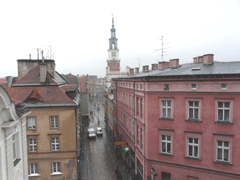
Poznan, Poland. (Photo: Bruce Gellerman)
BAN: We look for leadership from the United States. It is therefore encouraging to hear about the incoming administration’s plan to put alternative energy, environmentalism and climate change at the very center of America’s definition of national security, economic recovery, and prosperity.
CURWOOD: But for the moment George Bush is still in charge, and Jim Connaughton, the chair of the White House council on Environmental Quality, was in Poznan and defended the administration’s record on climate change.
CONNAUGHTON: We need to keep our eye on the ball. We need new technologies. We need strong emission commitments from every major economy. And we need to come up with practical courses of action working with the developing world. We can see a successful outcome by the end of next year, if we roll up our sleeves, focus on realistic objectives and practical actions. If we continue to reinvent the failed approaches of the past, I fear it will take many years before we come to an agreement. We can’t afford to wait.
CURWOOD: The failed approaches of the past? What do you mean?
CONNAUGHTON: Such as the omission of key emerging economies from taking on binding commitments. The lack of meaningful domestic programs that would back up the international commitments. And the inclusion of many, many issues irrelevant to the subject of climate change that are very well addressed in other UN settings and other multilateral settings.

President George W. Bush's absence from international climate change negotiations is noted in Poznan. (Photo: Ingrid Lobet)
CONNAUGHTON: They’ve got to hit the ground running; keep your eye on the ball. America has the leadership policies. America’s actually producing the leadership outcomes. We had a net decrease of greenhouse gases under President Bush of three percent. Second only to France among the major economies. They can build on that record, but they’ve gotta be realistic. Break the problem into its smaller parts, come up with agreement on what can be reasonably achievable, and then do your best to get it done. And try to stay away from the rhetoric. Focus on real outcomes.
CURWOOD: James Connaughton is the outgoing chairman of the White House Council on Environmental Quality.
Democrat John Kerry is the incoming chair of the Senate foreign relations committee. He came to Poznan in his official capacity as a senate leader, and as the eyes and ears of the president-elect.
KERRY: I think the Bush Administration has lost eight years on one of the most urgent subjects before the world. And I regret that they have consistently stonewalled the concept of mandatory targets and reductions of emissions. Now that said, they have advanced a sort of schedule for negotiations next year, and I give them credit for putting that in place and making sure that this process will continue with a meeting in March, with another meeting in June, where real negotiating will begin. And the next administration will have an opportunity to be there front and center. So I think it’s, you know, time to move on from the lost opportunities and start looking at the ones that have been found through these elections and through the inauguration of President Obama on January 20th.
CURWOOD: Now, privately, some of the senior officials from some of the negotiations here in Poznan say that you know, this is really frankly come down to just marking time. That it’s the end of the U.S. administration, things aren’t happening and, really, what needs to happen is that the U.S. and China need to sit down together and talk to work out how things will move forward, or to really get a text going.
KERRY: I think that’s part of it. But it’s going to take more than just the Chinese. The Chinese have surpassed us as the top emitter of greenhouse gases in the world. We’re number two. But close behind are India and Japan and then the European community and Korea and others, all of whom are going to have to be part of the solution.
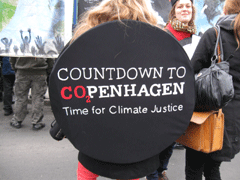
Attendees look forward to Copenhagen. (Photo: Ingrid Lobet)
KERRY: Well I think they can be very ready. There are many people who’ve been following this for a long period of time, myself included. So this is really a matter of leadership and willpower. There are details to be worked out in terms of cap and trade, auctions, mitigation funds, adaptation funds, but that’s gonna be a measure of each countries reasonableness in coming to the table. So we’re just gonna have to find the mechanisms, and I think over a year, we ought to be able to find the principal ones which are the target levels that the developed countries are prepared to adopt, mandatorily to reduce their emissions. That will set off, that’s a trigger that sets off a whole bunch of other actions that begin to flow from it. I think we can achieve that by Copenhagen.
CURWOOD: In your view, the process will be done in time to have a treaty in Copenhagen.
KERRY: No, I said I think we can achieve that in Copenhagen. It will depend on the quality of the leadership put forward by heads of states as well as the negotiators that are empowered by them to carry out their stated programs. I believe it can be done. The leadership is there. I will make a series of recommendations to President-elect Obama as to what I believe he ought to do to help make that happen, and my hope is that it will happen by Copenhagen. But nothing is a sure bet.
CURWOOD: What should happen next in terms of climate in our domestic policy? What has to be in a treaty to make your job possible, that is someone who would shepherd the treaty through the senate to ratification?
KERRY: It’s absolutely critical, I said this to the Chinese and to the Secretary General and to Mr. de Boer and to each of the delegations I met with, because they need to help urge this – we will not pass an agreement in the United States Senate that does not have a global solution. All countries must be part of this one way or the other. Not every country has to be required to live up to the same standard of reductions or the same rate of reduction, but they all have to be committed to not making the mistakes of the past as they develop and to reducing emissions. And how we – that is the key really to the Copenhagen framework if you will, is what are the targets and what rate do certain people undertake to achieve them.
CURWOOD: And of course we have to have those targets too.
KERRY: Oh yes, the United States of America must lead on this. We need to have mandatory reductions levels. And that goes for China, Japan, India, the European community, Mexico, Korea, the near-developed countries. All of us have to be part of this solution.
CURWOOD: On the whole question of the climate negotiations, do you wake up in the morning and look in the mirror and say I’m going to have to be an optimist today, or do you wake up with a smile knowing that this is happening?
KERRY: No I really am – I’m optimistic about it. I mean there’s a huge challenge. But I’m optimistic. Let me tell you why I’m optimistic. Because first of all, we’re already making enormous progress, even in the United States. People aren’t aware of it. Over half of our economy today is actually under a voluntary mandatory reduction schedule. New England, Chicago, Illinois and a group of states in the Midwest, out west – California, Washington, Oregon, a group of states joined together and they’ve accepted targets. Secondly, there are about 450 mayors or more who have led their cities into the future as part of a climate action partnership, the mayors’ conference, who are committed to city efforts. And so a city like Oregon, Portland, Oregon, has actually reached Kyoto levels of reductions by grassroots efforts in their own initiatives. So I’m optimistic, because I see what Americans are already doing, what people around the world are doing. Secondly, I’m optimistic because I see a silver lining in this economic crisis.
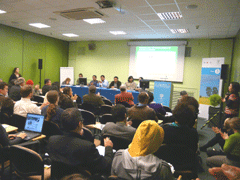
Panel discussion on indigenous people and climate change in Poznan. (Photo: Bruce Gellerman)
CURWOOD: John Kerry is the incoming chair of the Senate Foreign Relations Committee, Democrat from Massachusetts. Thanks so much, sir.
KERRY: Great to be with you. Thanks.
CURWOOD: For 12 days delegates met to debate and discuss how to fight climate change and find the money to do it. But Jennifer Morgan, global climate director for E3G, based in Berlin, says, when all was said and done - more was said than done.
MORGAN: The process is set. The chairs have what they need to drive home a deal in Copenhagen, logistically, mechanically. The politics is not set. There’s not trust now between the north and the south. Developing countries don’t believe that developed countries are actually going to come and do something. They’re not there on technology and finance yet.
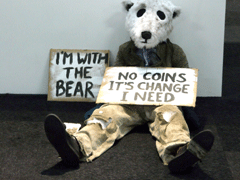
The talks on climate change attracted interested parties from all over the world. (Photo: Bruce Gellerman)
CURWOOD: Jennifer Morgan is global climate director for the group E3G.
From the crossroads of Poznan, Poland, the delegates now head home. And then in March, they go to Bonn, Germany, the next stop on the road to Copenhagen a year from now.
[MUSIC: Brave Combo “Lovers On Public Benches” from Polka’s Revenge (Dentone Records 2007)]
Coming up: Saving indigenous people, tropical forests and the planet. You’re listening to Living on Earth!
Related link:
The United Nations Framework Convention on Climate Change
A Treaty to Slow Deforestation
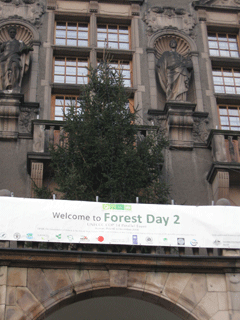
(Photo: Ingrid Lobet)
CURWOOD: It's Living on Earth. I'm Steve Curwood at the United Nations Climate talks in Poznan, Poland.
[SOUNDS OF MARCHERS CHANTING AND DRUMMING]
CURWOOD: Young people have filled the streets of Poznan several times in recent days to urge governments to move forward, on all fronts on climate change.
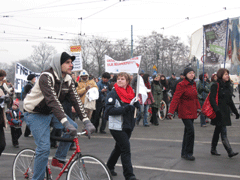
(Photo: Ingrid Lobet)
LOBET: Hi, Steve.
CURWOOD: So Ingrid, the notion that protecting forests could help fight climate change goes back to the earliest climate negotiations, but it never made it into the original Kyoto accord of 1997. What are people saying now about forests getting back on the agenda?
LOBET: Well, as it becomes clear that climate change isn't just something in the future, but already in the present - there's the growing sense that slowing tropical forest losses is a must. Consider that chopping and burning of tropical forests releases more greenhouse gases than all the cars and trucks driving around the planet. And deforestation might be slowed down a lot quicker than changing the whole car industry.
CURWOOD: Now I understand there have been some big announcements from Brazil and Peru on this?
LOBET: Yeah, just a few days ago, Brazil became the first major-emitter, developing country to take on targets to reduce greenhouse gases - they said they'd dramatically cut deforestation - and considering that Brazil and Indonesia together are responsible for about half of those forest emissions, that is a big deal.
Peru has also followed with a goal to get to zero deforestation.
[POLISH YOUTH ORCHESTRA: “OYE COMO VA”]
CURWOOD: Wait a second, Ingrid - are we in Peru?
LOBET: No we're in Poland. That's a youth orchestra playing Tito Puente to a large group of people gathered for a full day focused on forests.
LOBET: This was only the second time there's been a day devoted to forests and it drew nearly a thousand people. A lot of scientists and reforestation and agriculture experts. Not so many people who actually live in the Amazon and Indonesian forests. That's been a tension throughout this year's talks. But there are also increasing points of agreement in this crowd about how to address deforestation.
NILES: It is clearly one of the most devastating land use phenomenons on the planet.
LOBET: John-O Niles, director of the nonprofit Tropical Forest Group, points out deforestation isn't just the world's second largest source of greenhouse gases.
NILES: It is the largest source of species extinctions, it can have massive health and human impacts, it destroys biodiversity, biochemical diversity in species that we've yet to even discover.
LOBET: So as scientists find there's less time than we thought to avoid real climate disruption, people have gotten really interested in actions you can take that have a more immediate effect. Martin Parry is a research scientist and co-chair of last year's climate assessment.
PARRY: We've left ourselves a lot to do in a short time. To cut 1990 level emissions by 80 percent by 2050, starting now. We cannot possibly achieve this mitigation target without transforming global forest trends.
LOBET: Climate experts have long understood that forest emissions are a major part of global warming. But the whole question of land use, tropical and temperate forests became too complex to get consensus in earlier climate change talks. Since then, the desire and willingness of many tropical countries to address forest emissions has been growing.
Many take heart that if you can pay people who live in or near the forest to protect the trees, it holds the promise for addressing global warming, deforestation and rural poverty - all at the same time.
[SOUNDS OF PROTEST: “NO RIGHTS, NO REDD!”]
LOBET: But as interest in reducing emissions from deforestation grows, so have concerns about it. Here in Poznan, several indigenous groups protested when language explicitly recognizing indigenous rights didn't make it into official proposals. Instead, indigenous groups were invited to give input to the next stage of the talks. Jorge Furagaro, an Amazon leader from Colombia, said what's essential is that indigenous nations aren't just consulted about carbon-storing projects, but that they can veto them.
FURAGARO: [Speaking in Spanish] Through interpreter: What we don't want to see is negotiators coming down here, going around our leaders, to community members who don't read or write and then saying, "Look I've got their signatures."
LOBET: Many of the forest experts here say projects to store carbon in trees must not restrict poor people's access to the medicine, food, and fuel that they get in forests. They also shouldn't create incentives for governments to take control of native land.
EHRHART: This man is being arrested for going into a forest reserve.
LOBET: Charles Ehrhart is with Care International.
EHRHART: This is exactly what concerns many indigenous peoples and local communities. They're worried that what REDD carbon finance is going to do is provide the state with resources they have been previously lacking to enforce their claim: what you're going to see is carbon conservation enabling a fortress forest approach.

(Photo: Ingrid Lobet)
NURAIN: Let us be very clear: We should not let the self interest of countries who could not reduce emissions at home, and wanted a cheap deal, consulting companies, banks, to do creative carbon accounting, to do what is today being called counterfeit carbon currency creations. Forests are about survival of large numbers of poor people. This is not a resource that we can allow the world to play around with.
LOBET: Even if wealthier countries do pay a lot to tropical forest nations, more than they first imagined, avoiding deforestation and degradation may still be both cheaper and quicker than changing industrial systems. And that's why many people, including Lars Lovold of Rainforest Foundation Norway, are hopeful. He's been working with indigenous people on rainforest protection for 30 years.
LOVOLD: Suddenly we are willing to put money behind this on a totally different scale than before. We are now talking billions of dollars. This is a totally new situation, which actually makes it possible to protect forests.
LOBET: And Steve it's that possibility, of more attention and more money, that makes this issue hopeful despite the controversy.
CURWOOD: So Ingrid, how far does that hope carry us toward a real agreement? We're in Poznan right now. In just a year, in Copenhagen, they're supposed to come up with a full treaty.
LOBET: Well there’s a large and growing number of people who want forestry issues to be part of the world's united climate effort. So it's looking a lot more likely they're going to find a way to make this work.
CURWOOD: Thanks, Ingrid. We'll be checking in with you on these forestry issues again come January. In the meantime, thanks for coming to Poland.
LOBET: My pleasure.
[MUSIC: Tosca “Chocolate Elvis (Boozoo Bajou Soul Sufferer Version)” from Chocolate Elvis Dubs (G Stone Recordings 1999)]
Solar's Bright Future

The solar-powered car that went around the world without burning a drop of gasoline. (Photo: Bruce Gellerman)
[STREET SOUNDS]
CURWOOD: Parked in front of the U.N. Climate Conference here in Poznan, Poland is a head-turning vehicle unlike any car you’ve ever seen. It’s a bright blue, two-seater solar taxi - at least that’s what inventor Louis Palmer calls it. Over the past 17 months, Palmer has driven his unique, solar powered vehicle 33,000 miles, through 38 countries.
PALMER: And this is the first time in history the solar powered car is going all the way around the world. And this is to show that this new technologies are ready, affordable, reliable, economical and ecological.
CURWOOD: So around the world without a drop of gas.
PALMER: Absolutely. That is what I wanted to show. And I’ve shown it to the world. And we can even travel around the world without gas. So hey, we can go to school, we can go shopping, we can go to work with this technology. It’s all possible.
CURWOOD: The solar taxi is an ungainly three-wheeler. Hitched to the rear bumper is a flat bed trailer: 60 square feet of solar cells that speed Louis Palmer down the road at 60 miles an hour.
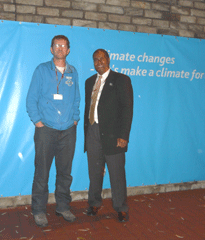
Steve Curwood and Louis Palmer, Swiss inventor of the solar taxi. (Photo: Bruce Gellerman)
CURWOOD: So how soon do you think we will be driving solar cars?
PALMER: That all depends on the will of the people to realize that we have to push these solutions. And it all depends on how long we have the oil lasting. I’m absolutely convinced it could happen tomorrow. In mass production this car could cost 10,000 euro. You put a solar cell’s worth of, let’s say, $5,000 on your roof top, and then you can drive for free for the next 40 years, for free. Every year you could make 10,000 miles.

Around the world without burning a drop of gasoline. (Photo: Bruce Gellerman)
ZHENGRONG: In the last few years actually we’ve proved we can make solar power our future. The dramatic cost reductions in the last few years, and as I say early on, we need only temporary support from governments, maybe three to five years’ time, that solar electricity can reach great parity level. Beyond that we think we can directly compete with generating cost of coal fired electricity plant.
CURWOOD: Suntech’s CEO Shi Zhengrong came to the climate talks here in Poznan, Poland to proselytize for solar technology. But while all manner of alternative power sources have been debated and discussed among delegates, conspicuously absent have been conversations about solar - particularly the conversations about providing money to advance this technology option.
Professor Maciej Nowicki is Poland’s Minister of the Environment and president of the Poznan Climate conference. He had to tell reporters that he wasn’t speaking in an official capacity when he mentioned solar energy’s role in mitigating climate change. He spoke through an interpreter.
NOWICKI: (through interpreter) My personal opinion is what I am giving you now - other nuclear solutions also very expensive but the solar energy will be available to all countries world wide, so for all countries in the world it will be the cheapest available source of clean energy for them to develop, so that’s why I’m talking about solar as the way to go in the future.
CURWOOD: Jeremy Leggett, Executive Chairman of Solar Century, a British solar energy company, and author of “The Carbon War,” took note of the dearth of official discussion about solar by delegates. He says, they lack vision.
LEGGETT: There’s a revolution going on right now, and this is the fastest growing energy business in the world. And yet when you look at the models that tend to come out of these negotiations, the advice that the negotiators get, you don’t see much evidence of people who fully understand that.
CURWOOD: What about the questions of subsidies at this point?
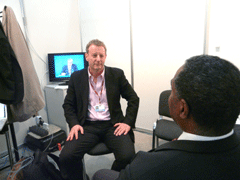
Steve Curwood interviews Jeremy Leggett, founder and executive chairman of SolarCentury.
CURWOOD: Jeremy Leggett, head of the British photovoltaic company: SolarCentury. He came to the Poznan climate talks to urge a broader inclusion of solar in the next international agreement to fight climate change.
Related links:
- Solar Taxi
- Solar Century
[MUSIC: Euphoria “Desert Drive” from Eden: A Collection Of Global Chill (Six Degrees Records 2007)]
Obama’s Environment Team Takes Shape
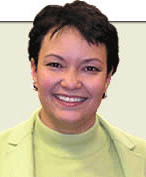
Incoming EPA administrator Lisa Jackson. (Courtesy of the New Jersey DEQ)
CURWOOD: While climate talks were underway here in Poland, in Chicago, President-elect Barack Obama was selecting the team that will lead his efforts on energy and climate change in Washington, DC.
Obama is expected to name Nobel prize-winning physicist Steven Chu to be energy secretary and former New Jersey environmental official Lisa Jackson to lead the U.S. Environmental Protection Agency. And Obama is creating a new White House energy and climate advisory position, to be led by former EPA administrator Carol Browner. Living on Earth's Jeff Young is with me now on the line from Washington with more on Obama's environment team. Jeff?
YOUNG: Dzien dobry, Steve. That's sort of Polish, I think?
CURWOOD: It’s close enough. So, Jeff a Nobel laureate to lead the department of Energy? Now, that's some intellectual heft.

Steven Chu. (Courtesy of the Lawrence Berkeley National Laboratory)
CURWOOD: And he really has spoken out on climate change, as well.
YOUNG: Absolutely. He says his growing sense of alarm about global warming is part of what's motivating his work. And at a recent conference he gave a pretty dark warning about what might happen with uncontrolled global warming.
CHU: Climate change of that scale will cause enormous resource wars over water, arable land, and massive population displacements. We're not talking about 10,000 people, we’re not talking about 10 million people, we are talking about hundreds of millions to billions of people being flooded out, permanently.
YOUNG: Probably the only criticism I've heard is that Chu has no political experience, and he'll face some tough politics as Obama pushes ahead with his climate and energy policy. You know, oil, coal, nuclear, you name the lobbyists, they’re all going to be lining up, angling for every possible advantage. The question is will Chu be as tough as he is clearly smart.
CURWOOD: Well, Carol Browner certainly brings political experience, a lot of it. She was in charge of EPA eight years, I believe that’s longer than anyone in the agency's history. Tell me about her new job.
YOUNG: Ah, yes, the energy czar, as it's been dubbed here in D.C. The idea here is that because climate change is a cross-cutting issue that requires attention from so many parts of government, you really need someone at a high level to coordinate those efforts. And Browner's been a very vocal advocate on global warming since she left EPA. And of course because of her experience at the agency she understands what government can and can't do in the way of regulating greenhouse gases. She spoke about that at an event earlier this month.
BROWNER: The Environmental Protection Agency, under the existing Clean Air Act, is sitting on some authority. The Supreme Court decision of two years ago gives them authority. I think most of us who have worked on these issues for a long time would agree, it's not the most refined authority, you can't get to cap and trade through this authority, but nevertheless, the president-elect will have some tools available should he decide to use those in the event that perhaps there can't be some sort of agreement with Congress on how to move legislation.
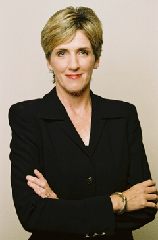
Carol Browner.
CURWOOD: New Jersey certainly has its share of environmental challenges as well. What's Lisa Jackson's reputation there?
YOUNG: I've heard mixed reviews from New Jersey environmentalists. There's some praise for her focus on clean energy, climate change, things like that. However, I heard from some who worked for her agency who thought it was not at its best during her tenure. So mixed reviews there. She's a chemical engineer, educated at Princeton, she would also be the first African-American to lead EPA.
CURWOOD: Well, it sounds like the president elect is putting together a team to really take on climate change, Jeff.
YOUNG: Oh, I definitely think so. You look at Mr. Chu on the science, hard to argue with the credentials of a Nobel laureate there. Ms. Browner on policy, lots of experience, and now Ms. Jackson at EPA able to perhaps bring in the state perspective to things. You combine that with the signals we've been getting from Obama since the election about his desire to really dig in on this, and I think we see the makings of an administration that's gearing up to act on climate change in a big way, and to attack it from a lot of different angles.

Lisa Jackson. (Courtesy of the New Jersey DEQ)
YOUNG: Dziękuje.
CURWOOD: Thanks.
[MUSIC: Chris McGregor “Andromeda” from Chris McGregor’s Brotherhood Of Breath (Maxine McGregor Records 1971)]
CURWOOD: Just ahead, the ABCs of the CDM and the COP – oh, don’t forget, the MOP. That’s just ahead right here on Living on Earth!
ANNOUNCER: Support for the Environmental Health Desk at Living on Earth comes from the Cedar Tree Foundation. Support also comes from the Richard and Rhoda Goldman fund for coverage of population and the environment. And from Gilman Ordway for coverage of conservation and environmental change. This is Living on Earth on PRI, Public Radio International.
Related links:
- Hear Steven Chu talk about energy and climate change
- Read Lisa Jackson’s speech when she started work as New Jersey’s environment commissioner
- Hear Carol Browner’s views on the importance of investing in clean energy
Poznan's Alphabet Soup
CURWOOD: It's Living on Earth, I'm Steve Curwood in Poznan, Poland.
Here, at the U-N-F-C-C-C- now that’s The United Nations Framework Convention on Climate Change – you have to learn the alphabet because we’ve got delegates attending the C-O-P 14 - the Conference of Parties - and representatives from N-G-Os, those are Non-Governmental Organizations – those folks are engaged in wide ranging discussions about G-H-Gs and C-D-Ms, and that would be – let’s see - Green House Gases and Clean Development Mechanisms.
And if you’re confused by the acronym alphabet soup, well, I’ve been coming since 1997, the session in Kyoto, to these meetings, and I’m still learning a lot. And here for the very first time is Living on Earth's Bruce Gellerman. Hi there, Bruce.
GELLERMAN: Hi, Steve. And boy, you are right. There is a lot to learn here. This place is enormous. You’ve got ten thousand delegates from around the world – you’ve got myriad media outlets, research institutions, public interest groups, and state and national and international organizations....and it seems each and every one goes by an acronym:
PEOPLE AT CONFERENCE: It's ECI and it's Environmental Change Institute. WMO and the full name is World Meteorological Organization. WFP, World Food Program. This is actually an easy one UNEP, United Nation's Environment Program. My acronym is SEI, it means the Stockholm Environment Institute and we're trying to bridge science to policy - that's our goal.
GELLERMAN: And the goal of the more than 1000 reporters attending the UNFCCC is to unscramble this multi-cultural, climate change crossword puzzle.
LOVELL: The one thing that climate talks have done is generate a complete industry of acronyms.
GELLERMAN: Jeremy Lovell, a veteran Reuters reporter, is attending the Poznan climate summit.
LOVELL: There are bingos, ringos, namas, napas, all sorts of them, cops, mops, but then the mop is also CMP which is confusing when acronyms have acronyms of their own. I remember what some of them stand for but not all of them by any means.
GELLERMAN: Lovell was hired as a freelance journalism instructor for the Poznan summit. He gives workshops to help reporters understand the complex scientific issues and political negotiations - and navigate the sea of acronyms.
LOVELL: I'm working for a group called COM plus.
GELLERMAN: What is COM plus?...C-O-M +.
LOVELL: C-O-M with a plus sign, yes.
GELLERMAN: Is it an acronym?
LOVELL: Ha-ha...If you like yes, I don't know what the COM stands for. It’s probably for communications. But is it an acronym in its own right? Yeah.
GELLERMAN: It's hard to keep up with. It's impossible to keep up with.
LOVELL: It's virtually impossible to keep up with. Even the negotiators find it hard sometimes to remember which acronym refers to what specific activity.
SUAREZ: The issue is that if you do not use acronyms, it takes you half an hour to say something.
GELLERMAN: Pablo Suarez is ADP - the associate director of programs for the IFRC, the International Federation of Red Cross.
SUAREZ: We are noticing that for our own work for the Red Cross to know what to do, we have to learn a ton of acronyms - otherwise we don't know who to talk to, we don't know what to say when we meet them and we have no way to understand what they're telling us when they tell us follow the UNFCCC AG W-4, etc. So it is a short cut - the problem is only those who know the shortcut can get there.
GELLERMAN: And at a conference where there are people from nearly 190 nations, even knowing the same acronym sometimes doesn't help. Lena Nerlander is with the Red Cross / Red Crescent Climate Center.
NERLANDER: We were talking about the same thing, but I was not understanding that he was talking about the same acronym that I was talking because acronyms in different languages change.
GELLERMAN: It used to be, "The more things change, the more they stay the same,” except, perhaps for language....and the climate.
At the U-N-F-C-C-C in Poznan Poland...I'm BG for PRI's LOE.
Seeing Our Planet, Finding Ourselves
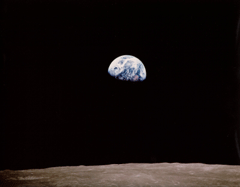
Earth, seen for the first time by human eyes from space, taken by Astronaut Bill Anders. (Courtesy of NASA)
CURWOOD: On December 21st, 40 years ago, three men boarded a spaceship and became the first humans to fly to the dark side of the moon.
[SOUND OF TAKEOFF, “3 - 2 – 1”]
CURWOOD: Three days later, the Apollo 8 crew - Frank Borman, James Lovell, and William Anders, also became the first earthlings to orbit a celestial body - a big step towards delivering on the pledge of President Kennedy to put a man on the moon.
But what the world most remembers about Apollo 8 is the image the crew brought home, as for the very first time humans saw and photographed Earth from space....rising blue, round, and small, over the moon's horizon. Historian Robert Poole of the University of Cumbria in the U.K. is the author of the new book, “Earth Rise: How Man First Saw the Earth."
POOLE: What was most exciting about the moon missions wasn’t what was most significant in the longer term. I mean we now know that the moon is a dead rock and we know it has a common geological history with the earth. But what’s really remained with us is the vision of the whole earth. I mean it’s quite difficult now to go back to the 1960s to a time when nobody had seen the earth. It was an immensely powerful sight, to see the earth, to see our home, whole and complete. And to see all of mankind in the frame at once, apart from the three guys behind the camera. That’s quite a thought.
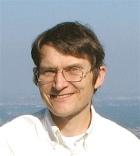
Robert Poole.
POOLE: Rather extraordinarily. The Earth rising over the moon took them by surprise. They had anticipated it in a general kind of way, but they were so busy with all the various tasks that they had to do, they were orbiting the moon for the first three times, what they called sort of general interest photos were right at the bottom of the list, and amongst those they said, oh, we might get one or two good views of the earth. Just before they got into radio contact they saw the earth rising over the lunar horizon.
CURWOOD: Not only were the astronauts aboard Apollo 8 not scheduled to take this shot, they weren’t scheduled to go to the moon as I understand it.
POOLE: No. Originally Apollo 8 was supposed to test the lunar lander in earth orbit. But the problem was the lunar lander was quite a complex bit of equipment and it wasn’t ready in time, and so NASA took this really very dangerous decision to send Apollo 8 all the way to the moon. They said well, if we can’t test the lunar lander, why don’t we test actually going to the moon. So they had an unplanned mission, which was to go to the moon, to orbit the moon, to survey the back on the moon and to come back and to test the Apollo rocket all up, all five million parts at one go with humans on board. I don’t think health and safety people would allow a risk like that to be taken these days. It was a risk, the astronauts were willing to take it, and the fact that they got there safely and then saw the earth, they saw home sort of beckoning them and pulling at them made it all the more dramatic when the earth actually came over the lunar horizon.
CURWOOD: Now what role did Richard Underwood, the trainer of the astronauts in photography, what role did he play in getting this picture?
POOLE: A very important one. I mean he should go down in history really as the man who photographed the earth. Because Underwood briefed the astronauts and he said to them, look, all this data that you gather is going to end up in some dusty library. What will live on is the pictures, I want you to take some great pictures of the earth for me. But as far as the official mission plan was concerned, these were bottom order snaps, the lowest priority.
CURWOOD: It’s said that they went to the moon and discovered the earth on this mission, that Astronaut Frank Borman said that this must be what God sees?
POOLE: Yes as he was leaving the earth, he looked back and the astronauts remembered, We could see the earth start to shrink. Nobody had seen the whole earth. Satellites has seen parts of it, even all of it, but it didn’t have the same impact as actually seeing the earth shrinking out of your window. And Borman was a deeply religious man and his thought was, this must be what God sees. And so the astronauts felt that they’d been given really quite a special view - of the creation I guess, and this in turn influenced what they decided to say when they actually broadcasted the earth from orbiting the moon on Christmas Eve.

Earth, as seen for the first time by human eyes from space, taken by Astronaut Bill Anders. (Courtesy of NASA)
POOLE: They chose in advance to read the creation story from the Bible.
BORMAN: In the beginning, God created the heaven and the earth. And the earth was without form and void and darkness was upon the face of the deep. And the spirit of God moved upon the face of the waters and God said let there be light. And there was light. And God saw the light, that it was good.
POOLE: It took us almost outside of the human side of the space program, back to basics. This was almost earth seen at the moment of creation.
BORMAN: And from the crew of Apollo we close with goodnight, good luck, a merry Christmas, and God bless all of you, all of you on the good earth.
CURWOOD: And this is an ultimate kind of spiritual, profound experience. What happened to these men as a function of seeing the earth rise?
POOLE: Well, if you look back at the history of the astronauts, those who were mostly profoundly affected by looking back at the earth, were those who had the most time, those who were orbiting the moon waiting for the other astronauts to come up, or those who were in the less busy seat. And we’ve had some quite profound meditations from astronauts, you can see in the film “In the Shadow of the Moon” that came out last year, some of them talking about how happy they are now to be back down on the earth. One of them says its like being in the Garden of Eden. I think about that every day.
[ASTRONAUTS IN THE MOVIE “IN THE SHADOW OF THE EARTH”: I felt that I was literally standing on God’s front porch…. I can remember thinking my God, that little thing is so fragile out there….That jewel of earth was just hung up in the blackness of space.]
CURWOOD: Now the first Earth Day takes place what about 15 months later after Apollo 8, in 1970. What role do you think the earthrise played in the first Earth Day?
POOLE: Well it’s absolutely immediate. John McConnell who’s a peace and internationalist activist sees the Apollo 8 photograph of the earth floating in space and asks NASA for a copy of it, which they’re very pleased to supply. And he has it printed on a flag, which he calls the earth flag, and in July of 1969 McConnell distributes 50 of these flags, and they’re small pennants, showing the earth to the people at the moon watch, watching the Apollo 11 landings. And later has the idea of having an Earth Day, a day to celebrate the earth, to look after the earth. It’s a kind of – it’s the first environmental festival. And it’s soon followed by another version of Earth Day, which is planned by Senator Gaylord Nelson over on the east coast. And Earth Day has been on American calendars every since.
CURWOOD: Right now the world is busy trying to negotiate a successor to the Kyoto accord to combat climate change. As you look back at the change in the consciousness in our civilization with this picture, what role do you think it might play in the ongoing negotiations to perhaps save the world from, well, climate disruption and destruction?
POOLE: I think it’s already played the role because climate scientists, and in particular James Lovelock who came up with the Gaia theory, the idea that the earth is kind of a limited, self regulating mechanism - they now understand the earth as a complete set of complex systems, and that if you change anything that happens in one of those systems in a major way, other things will happen as well. Global warming is simply common sense from this point of view. Scientists could understand that in a technical way, but ordinary people could understand it when they saw the earth, when they saw that outside the earth there was nothing. Everything that goes on on the earth happens inside this very small atmosphere, this very thin skin that’s no more that the thickness than a peel or an apple. When you can see the earth as complete and whole on its own, you understand that it is one system, that if you do start to change it, to pollute it, to spoil it, to damage it, the earth itself will start to change because there’s nothing but immense blackness for a vast distance outside it. So when we see the earth, we understand that it’s an integrated whole and that it needs to be approached as a whole in order to, well, keep it as a viable environment for human beings.
CURWOOD: Robert Poole, thank you so much for taking this time with me today.
POOLE: Thank you very much. It’s been good to talk to you.
Robert Poole’s new book is called, “Earth Rise: How Man First Saw the Earth."
Related link:
For more pictures and information, check out the Earthrise website
A Taste of Tales to Come
[SOUND OF GONG]
XIONG: Loooong time ago there was no sun, there was no moon, there were no trees on earth, no people, no animals, it was a dark and quiet place.
CURWOOD: In this dark and quiet time of the year in the Northern hemisphere - and let me tell you, here at the climate change talks in Poland it gets dark by about three in the afternoon - we at Living on Earth take a break from the news and turn to storytelling. So on our holiday special next week, we’ll bring you tales with an Eastern flavor, like this one from Tou Ger Xiong, a Hmong-American born in Laos, and raised in Thailand and Minnesota.
XIONG: I think stories are empowering. I grew up listening to stories. As a Hmong American growing up here I would listen to the storytellers that my librarian at school would tell. You know they take their little book and they open up, and they’ll start, Once upon a time there was a bear named Tom….
And that was story telling at school, but when I came home my dad told stories, but he told ‘em Hmong style. And if you know Hmong language, it’s a tonal language similar to the Chinese language in that it flows like music. My father told Hmong story in his own way, and he begins… “[Speaking Hmong]… Loooong time ago there was no sun, there was no moon. There were no trees on earth, there were no people, no animals. It was a dark and quiet place. And from this little crack in the mountain, this man came.” And that was a typical Hmong story, folktale, about the beginning of the world.
And most Hmong families in the United States will have a story of crossing the Mekong River. It’s our story of the Trail of Tears, and it’s our story of the underground railroad or the internment camps. The Mekong River separates Laos from Thailand, and it’s a very symbolic place in the history of our people, of Hmong Americans, because after the communists take over southeast Asia, of Laos, there was a secret document circulating the new communist government saying annihilate and kill the Hmong in revenge for helping the Americans. So thus began the exodus of Hmong people leaving Laos.
We made our escape crossing the river in September of 1975. My father had this plan to get us closer to the border, and we heard about families who made it across the river, we heard about those who died trying, ’cause we knew soldiers were up and down the banks of the river waiting to shoot people who tried to leave. But we also knew that to survive we had to risk it because there were some refugee camps along the Thai border set up specifically to help Hmong refugees who did make it across.
So my father had secretly arranged for some Laotian fishermen who had a boat and access to the river who knew certain parts of the river were not patrolled as heavily as others. They came to meet us by the banks of the river at one o’clock in the morning. My father had paid them some money like he’d promised. So my family got on board, they took us across, and in my mother’s words, she said it was raining season, there was some lightning, thunderstorm. The boat was literally just inches away from overfilling with water. And she said the whole time she just prayed to our ancestors for them to watch over us and to guide us and to protect us.
CURWOOD: Stories from the Mekong River, Japanese-American internment camps, and Long Beach, California - next week on Living on Earth's holiday special. Be sure to join us.
[SOUND OF STAFFS STRIKING THE GROUND]
CURWOOD: We leave you this week on the streets of Poznan, Poland.
[SOUND OF STAFFS STRIKING THE GROUND]
CURWOOD: In an underground pedestrian passageway, near the old town square, an unfamiliar sound reverberates.
[SOUND OF STAFFS ON THE GROUND]
CURWOOD: A group of young scouts, boys and girls, dressed in grey uniforms, checkered neck scarves and black berets, strike their long wood staffs on the ground, the sounds echoing as the scouts climb the stairs to the city street.
[SOUND OF WALKING UP STEPS]
[KIDS CHANTING IN UNISON]
Living on Earth is produced by the World Media Foundation. Our crew includes Ashley Ahearn, Bobby Bascomb, Eileen Bolinsky, Bruce Gellerman, Ingrid Lobet, Helen Palmer, Mitra Taj and Jeff Young, with help from Sarah Calkins and Marilyn Govoni.
Our interns are Sandra Larson and Jessie Martin. Jeff Turton is our technical director. Alison Lirish Dean composed our themes. You can find us anytime at loe.org.
From the U.N. climate change talks in Poznan, Poland, I’m Steve Curwood, executive producer. Thanks for listening.
ANNOUNCER: Funding for Living on Earth comes from the National Science Foundation, supporting coverage of emerging science, and Stonyfield Farm: organic yogurt and smoothies. Stonyfield pays its farmers not to use artificial growth hormones on their cows. Details at stonyfield.com.
Support also comes from you our listeners, the Ford Foundation, the Town Creek Foundation, the Oak Foundation, supporting coverage of climate change and marine issues; The Bill and Melinda Gates Foundation, dedicated to the idea that all people deserve the chance to live a healthy productive life. Information at gates foundation.org; and Pax World Mutual Funds: socially and environmentally sustainable investing. Pax World: for tomorrow. On the web at paxworld.com.
ANNOUNCER: PRI, Public Radio International.
Living on Earth wants to hear from you!
Living on Earth
62 Calef Highway, Suite 212
Lee, NH 03861
Telephone: 617-287-4121
E-mail: comments@loe.org
Newsletter [Click here]
Donate to Living on Earth!
Living on Earth is an independent media program and relies entirely on contributions from listeners and institutions supporting public service. Please donate now to preserve an independent environmental voice.
NewsletterLiving on Earth offers a weekly delivery of the show's rundown to your mailbox. Sign up for our newsletter today!
 Sailors For The Sea: Be the change you want to sea.
Sailors For The Sea: Be the change you want to sea.
 The Grantham Foundation for the Protection of the Environment: Committed to protecting and improving the health of the global environment.
The Grantham Foundation for the Protection of the Environment: Committed to protecting and improving the health of the global environment.
 Contribute to Living on Earth and receive, as our gift to you, an archival print of one of Mark Seth Lender's extraordinary wildlife photographs. Follow the link to see Mark's current collection of photographs.
Contribute to Living on Earth and receive, as our gift to you, an archival print of one of Mark Seth Lender's extraordinary wildlife photographs. Follow the link to see Mark's current collection of photographs.
 Buy a signed copy of Mark Seth Lender's book Smeagull the Seagull & support Living on Earth
Buy a signed copy of Mark Seth Lender's book Smeagull the Seagull & support Living on Earth

